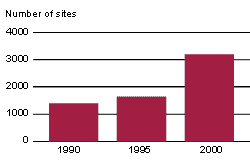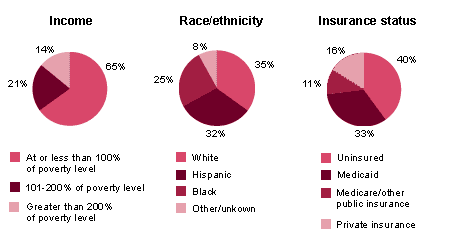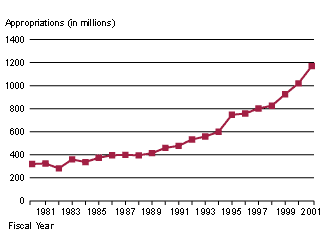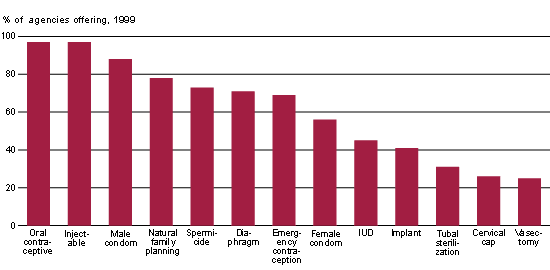Community health centers have provided comprehensive health services to low-income Americans for more than 30 years. Like many other modern-day health care programs for low-income Americans, including the Title X family planning program, community health centers trace their roots to President Johnson's War on Poverty. At that time, public health experts were beginning to understand that health and socioeconomic status are related, and that low-income people not only suffered disproportionately from illness but also had decreased access to needed health care. This produced a social and political consensus that addressing the health care needs of low-income people could achieve the twin goals of improving health and alleviating poverty ("Title X: Three Decades of Accomplishment," TGR, February 2001).
In 1965, the Office of Economic Opportunity (the federal agency then responsible for promoting community-based poverty prevention programs) made its first federal grants for subsidized family planning services. That same year, it issued demonstration grants to eight neighborhood health centers charged with delivering comprehensive health services to low-income individuals living in medically underserved areas. These grants sought to provide both low-income Americans insured through the newly created Medicaid program and the uninsured a place where they could access affordable health care services.
Just as the family planning grants of the 1960s evolved into Title X of the Public Health Service Act—a program dedicated specifically to the provision of subsidized family planning services—the neighborhood health centers evolved into the Community Health Center program, a categorical program created in 1975 by Congress and devoted to providing affordable, comprehensive health services to low-income people. Over the years, the number of community health centers grew significantly, but major legislative action in this area did not occur again until 1996, when Congress passed the Health Centers Consolidation Act. This legislation brought together authority for the community health center program and three other related primary and preventive health care programs—programs supporting migrant health centers, health care for the homeless and health care for residents of public housing—under Section 330 of the Public Health Service Act. Congress is now in the process of reauthorizing the consolidated program; its statutory authorization expired September 31, 2001.
Profiling the Centers
According to the Bureau of Primary Health Care (BPHC), the division of the U.S. Department of Health and Human Services that administers the community health center program, in 2000 approximately 750 community health center agencies ran 3,200 service sites in medically underserved rural and urban areas. The number of service sites grew significantly over the past decade, up from approximately 1,400 in 1990 (see chart), and today sites are located in all 50 states. Community health centers are private, nonprofit community-based organizations. Federal law requires each community health center to have a board of directors, the majority of whose members are users of the health center.
| Rapid Growth |
| The number of community health centers doubled in the 1990s. |
 |
|
Source:1990 and 1995—Bureau of Primary Health Care (BPHC), Experts with Experience: 1990-2000, Bethesda, MD: BPHC, p. 8; 2000-BPHC, personal communication, September 2001. |
Last year, according to BPHC, community health centers provided services to almost 10 million people, up from five million in 1990. This year, community health centers are expected to serve an additional one million people. Overwhelmingly, community health center patients are poor or have a low- income: According to a report published in 2000 by the General Accounting Office (GAO), 65% have incomes at or below the federal poverty level, and another 21% have incomes between 101% and 200% of poverty (see chart). Because poverty status is closely linked with race and ethnicity in the United States, community health center patients are disproportionately from racial and ethnic minority groups: While 29% of people nationwide are minorities, at least 60% of community health center patients are minorities. Four in 10 community health center patients are uninsured, and one in three are covered through Medicaid. Almost three in 10 community health center patients (29%) are women of childbearing age.
| Health Center Patients |
| Most patients receiving services at community health centers are poor, minority, and either uninsured or receiving public medical assistance. |
 |
|
Source: U.S. General Accounting Office (GAO), Community Health Centers: Adapting to Changing Health Care Environment Key to Continued Success, Washington, DC: GAO, 2000, p. 11. |
In FY 2001, Congress appropriated $1.17 billion for the community health center program. Similar to the national network of family planning clinics, community health centers draw on a variety of funding sources. Both have also experienced similar changes in their funding pattern over time, in that Medicaid has surpassed dedicated federal grants as a proportion of overall funding. In 1980, federal grants accounted for one in two community health center dollars, compared with less than one in four today. According to GAO, in 1998 Medicaid was the largest source of funding for community health centers (35%), followed by federal grants (23%), state, local and private grants (13%), Medicare (7%), private insurance (7%) and out-of-pocket payments (7%).
Community health centers are required by law to offer a wide range of primary and preventive care services, including lab tests and X rays, as well as referrals for related services such as mental health care and substance abuse treatment. They must also provide services designed to help patients access health care, such as outreach, transportation and translation services. The statute further mandates the provision of case management and linkages to other public assistance and social service programs. Services must be available to all local residents, and centers must establish a sliding fee scale so that patients are charged based on their ability to pay.
Reproductive Health Care
Key reproductive health services required by the community health center statute include prenatal care, screening for breast and cervical cancer, and voluntary family planning, as well as basic health care services provided by an obstetrician or gynecologist. In an effort to avoid duplication, the community health center program does not publish its own detailed protocols governing the delivery of specific health care services, but instead encourages community health centers to follow established guidelines or protocols of other agencies and professional organizations, including the American College of Obstetricians and Gynecologists. Therefore, unlike the Office of Population Affairs, which administers Title X, BPHC has published no program guidelines specific to the delivery of family planning or other reproductive health care.
Data suggest that community health centers play an important role in some key areas of reproductive health care. The National Association of Community Health Centers reports that each year such centers provide prenatal care for 400,000 births to community health center patients, or one in 10 live births nationwide. Moreover, BPHC notes that rates of infant mortality and low birth weight among health center patients are lower than rates for the general population. A study published by BPHC staff in 1999 in the Journal of Ambulatory Care Management also found that female health center patients are more likely to obtain mammograms and Pap tests than are low-income women in the general population: Sixty-four percent of female health center patients aged 50 and older received regular mammograms, compared with 45% of low-income women generally; 89% of female health center patients aged 18 and older had a recent Pap smear, compared with 75% of all low-income women.
The picture is somewhat less complete when it comes to family planning. According to BPHC, in 2000, 96% of community health center agencies reported that they provided family planning in at least one of their service sites. However, a 1997 survey of family planning clinics nationwide by The Alan Guttmacher Institute (AGI) found that of the roughly 2,500 community health center service sites that existed at the time, only 1,500 (60%) reported providing contraceptive care, even though family planning services are required by statute. These sites provided contraceptive services to 681,000 American women; in other words, only a small proportion (8%) of the 8.3 million community health center patients served that year were contraceptive clients. These clients represented approximately three in 10 (28%) female health center patients of reproductive age.
AGI's survey findings also gives a sense of how community health centers fit into the larger universe of family planning clinics. All in all, the 1,500 community health center service sites that provide family planning services constitute 20% of the 7,000 family planning clinics nationwide; however, they serve only 10% of the 6.6 million women who visit publicly funded family planning clinics. Additionally, about one in eight community health center service sites (300) reported receiving Title X funding in 1997, which would require them to comply with Title X regulations and program guidelines. These regulations and guidelines require a comprehensive package of services to be provided to family planning clients and spell out detailed protocols for the delivery of family planning services (mandating, among other things, confidentiality, full method choice, and nondirective options counseling for pregnant women).
Another AGI study to be published in 2002 sheds additional light in this area—namely, on the range of contraceptive methods offered by community health centers, as well as their cost. This AGI survey of agencies that run family planning clinics found that of the 550 health center agencies that provided family planning in 1999, almost all offered oral contraceptives and the injectable (Depo-Provera), seven in 10 offered diaphragms and emergency contraception, and between four and five in 10 offered the IUD and the contraceptive implant (Norplant)—methods that must be provided by specialty medical staff (see chart). One percent of contraceptive clients at community health centers received emergency contraceptive pills in 1998. Overall, community health center agencies offered clients the same number of contraceptive methods as health department agencies, but provided fewer choices than either hospital or Planned Parenthood agencies. However, they also tended to charge less for contraceptive methods (particularly for their poorest clients) than hospital or Planned Parenthood agencies.
The Future of the Centers
In recent years, community health centers have enjoyed tremendous good will in Congress, which has translated over time to significant annual funding increases (see chart). Community health centers also feature prominently in the Bush administration's plan for dealing with the problem of the uninsured. As part of his FY 2002 budget request to Congress, President Bush proposed a $124 million increase in funding for the program, in order to bring the number of health center service sites up to 3,400 (serving 11.5 million people). According to the administration, this would represent a significant down payment on its proposal to increase the number of health centers by 1,200, and the number of people served by six million, over the next five years. The administration has also set a longer-term goal of doubling the community health center patient population.
| On the Rise |
| Federal appropriations for community health centers have risen steadily over the past two decades, and this increase has accelerated over the past several years. |
 |
|
Note: Appropriations listed for 1981-1994 are for the community health center program only; appropriations for 1995-2001 are for a consolidation of four programs: community and migrant health centers, health care for the homeless and public housing services grants. Source: The Alan Guttmacher Institute, 2001, unpublished tabulations. |
Regardless of whether the health center program grows in accordance with the president's plan, current trends suggest that increasing numbers of low-income Americans are likely to rely on community health centers for their health care—including family planning care. Yet an examination of the existing data regarding the delivery of family planning services in community health centers suggests that important information gaps exist and critical questions remain. For example, why do some community health center service sites report that they do not provide voluntary family planning services when it is explicitly required by statute? Do those that do not offer family planning services on-site adequately refer women elsewhere for high-quality, low-cost services? Moreover, do community health centers that provide provide family planning operate under different rules depending on whether they receive Title X funding, and if so, how do these services differ in quantity and quality? These questions need to be answered regarding community health centers' ability to meet low-income women's family planning needs.
| Community Health Centers and Contraception |
| Community health center agencies almost universally offer several contraceptive methods, although many of them do not offer key methods that involve specialty medical training. |
 |
|
Source: Finer LB, Darroch JE and Frost JJ, U.S. agencies providing contraceptive services in 1999, Family Planning Perspectives, 2002, forthcoming. |
